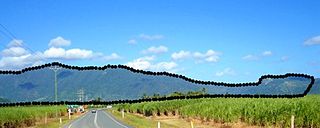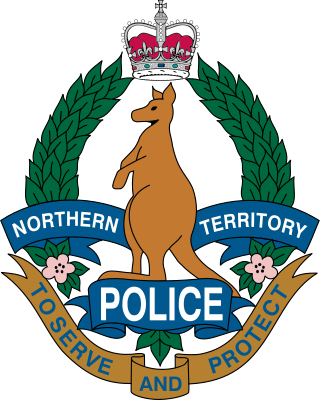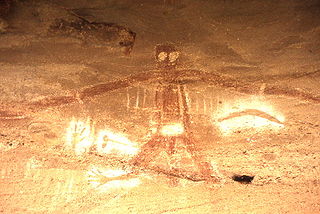
Australian Aboriginal religion and mythology is the sacred spirituality represented in the stories performed by Aboriginal Australians within each of the language groups across Australia in their ceremonies. Aboriginal spirituality includes the Dreamtime, songlines, and Aboriginal oral literature.

The Wandjina, also written Wanjina and Wondjina and also known as Gulingi, are cloud and rain spirits from the Wanjina Wunggurr cultural bloc of Aboriginal Australians, depicted prominently in rock art in northwestern Australia. Some of the artwork in the Kimberley region of Western Australia dates back to approximately 4,000 years ago. Another closely related spirit entity is the creator being Wunngurr, a being analogous to the Rainbow Serpent in other Aboriginal peoples' belief systems, but with a different interpretation.

Jedda, released in the UK as Jedda the Uncivilised, is a 1955 Australian film written, produced and directed by Charles Chauvel. His last film, it is notable for being the first to star two Aboriginal actors, Robert Tudawali and Ngarla Kunoth in the leading roles. It was also the first Australian feature film to be shot in colour.

The Northern Territory Police Force is the police body that has legal jurisdiction over the Northern Territory of Australia. This police service has 1,607 police members made up of 83 senior sergeants, 228 sergeants, 912 constables, 220 auxiliaries, and 64 Aboriginal Community Police Officers. The rest of the positions are members of commissioned rank and inoperative positions. It also has a civilian staff working across the NT Police, Fire and Emergency Services.
The Indigenous All-Stars is an Australian rules football team composed of players that identify as Indigenous Australian or with an indigenous culture.

Toomelah is an Aboriginal Australian community in the far north of inland New South Wales, Australia.

An Australian Aboriginal sacred site is a place deemed significant and meaningful by Aboriginal Australians based on their beliefs. It may include any feature in the landscape, and in coastal areas, these may lie underwater. The site's status is derived from an association with some aspect of social and cultural tradition, which is related to ancestral beings, collectively known as Dreamtime, who created both physical and social aspects of the world. The site may have its access restricted based on gender, clan or other Aboriginal grouping, or other factors.
George Kenneth Saunders (1910–2005), also known as Ken Saunders, was a New Zealand writer, born in England, who had a substantial career in Australia.
Josephine Mary Flood, is an English-born Australian archaeologist, mountaineer, and author.
"A Time to Speak" is a 1965 Australian television film that aired on ABC. This period drama, set around 1900, was written by Noel Robinson. It was the third production to air within a three- week period. The film premiered on 7 April 1965, in Sydney and Melbourne.
The Cell is an Australian play by Robert Wales. The setting is in a school for delinquent girls.
"Point of Departure" is a 1966 Australian television film. It screened as part of Wednesday Theatre. Australian TV drama was relatively rare at the time. "Point of Departure" aired on 22 June 1966 in Sydney, on 29 June 1966 in Melbourne, and on 27 July 1966 in Brisbane.
Wednesday Theatre is a 1960s Australian anthology show which aired on the ABC.
"Plain Jane" is a 1966 Australian TV movie. It stars Elspeth Ballantyne and was produced by Oscar Whitbread for the ABC. "Plain Jane" aired on 5 January 1966 in Sydney and Melbourne, and on 25 May 1966 in Brisbane.
The Man Who Shot the Albatross is a play by Ray Lawler about the Rum Rebellion, first performed in 1971 and turned into a 1972 TV movie featuring the same cast.
I, the Aboriginal is an Australian book and television film about the life of Aboriginal Australian Phillip Roberts.

The Territory Labor Party, officially known as the Australian Labor Party (Northern Territory Branch) and commonly referred to simply as Territory Labor, is the Northern Territory branch of the Australian Labor Party. It has been led by Selena Uibo, the first Aboriginal woman to lead a major political party in Australia, since 3 September 2024.
Kain is a 1966 play loosely based on the biblical story of Cain and Abel. It was the first co production between the ABC and the BBC.
Julianna Allan was an Australian actress. She played an Aboriginal girl in Wandjina! (1966).
Claude "Candy" Williams (1929–1983) was an Aboriginal Australian musician, known for his country and western singing, often termed the Aboriginal country music. He was an active advocate for the advancement of his people, and also appeared in several television films and series.







